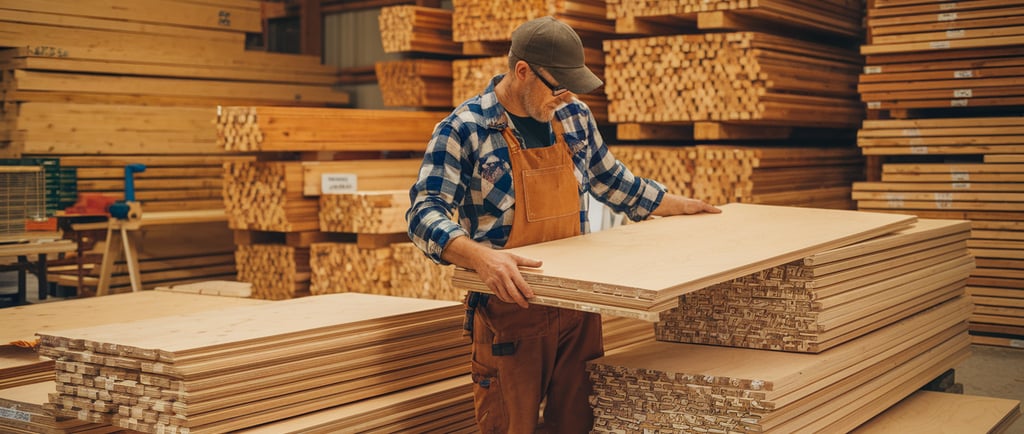Best Lumber for Construction: A Guide to Top Building Materials
Discover the best lumber for construction projects, including plywood, framing lumber, and more. Get expert tips to choose the perfect materials for your project!
12/10/20245 min read


Selecting the best lumber and plywood for your building project is one of the most critical decisions you’ll make when planning any construction or renovation effort. The choices you make not only determine the structural integrity and durability of your project but also influence the overall aesthetic, environmental impact, and cost-effectiveness of the final result. Whether you're constructing a new home, working on furniture, or tackling an ambitious DIY building project, understanding the wide range of building materials available can save you time, money, and future headaches.
With so many options to choose from, including softwood, hardwood, and a variety of plywood types, selecting the right material may feel overwhelming. This guide aims to break down the complexities, helping you choose materials that align with your specific construction projects, climate considerations, and budget.
Types of Lumber for Building Projects
When embarking on any building project, the type of lumber you choose lays the foundation for success. Lumber comes in various species and grades, each suited to specific applications ranging from structural framing to decorative accents. Understanding the strengths and weaknesses of different types of wood used in construction is key to making an informed decision.
1. Douglas Fir
Douglas Fir is a popular softwood known for its strength and versatility.
It’s often used in framing lumber and heavy-duty structural applications.
Features a straight grain that makes it an excellent choice for both house construction and flooring.
Easily sourced from local yards, making it a sustainable and affordable option for many projects.
Douglas Fir isn’t just for strength. Its consistent grain and minimal knots make it easier to work with than many alternatives, especially for precision projects requiring smooth finishes. Its availability in treated forms enhances its longevity for exterior use, such as decks or pergolas.
2. Western Red Cedar
Western Red Cedar is highly valued for its natural resistance to decay and insects.
Ideal for outdoor construction projects like decks, fences, and siding.
Provides a warm reddish tone and a pleasant aroma, making it a favorite for quality furniture and decorative applications.
One of the standout features of Western Red Cedar is its thermal insulating properties, which can reduce heating and cooling costs in homes. This unique characteristic makes it a sustainable choice for energy-conscious builders. Its lightweight nature also makes it easier to transport and install compared to denser woods.
3. Yellow Pine
Yellow Pine is a durable and cost-effective softwood commonly used in house construction.
Offers excellent strength, making it suitable for flooring, framing, and structural applications.
Its distinctive grain and hardness make it versatile for both construction and furniture projects.
Yellow Pine stands out for its ability to take stains and finishes beautifully, allowing builders to achieve a polished, professional look without investing in more expensive hardwoods. It’s also a top choice for structural subfloors due to its impressive load-bearing capabilities.
4. Hardwood Options
Hardwoods like oak, maple, and cherry are typically reserved for furniture and flooring due to their density and aesthetic appeal.
While more expensive than softwood, their durability and beauty make them an excellent choice for high-end building projects.
Hardwoods are highly resistant to wear and tear, making them ideal for projects in high-traffic areas, such as stairs or commercial flooring. They also have excellent acoustic properties, often used in musical instrument crafting or soundproof spaces.
Types of Plywood for Construction Projects
Plywood is an indispensable material in modern construction, prized for its versatility, affordability, and strength. Depending on the grade and type, it can be tailored to meet specific needs, whether structural or decorative. Understanding the different varieties ensures that your construction projects achieve optimal results without overspending.
1. Structural Plywood
Designed for heavy-duty construction projects, such as house framing and flooring underlayment.
Made from durable softwood veneers, often Douglas Fir or Yellow Pine.
Provides excellent load-bearing capacity and moisture resistance.
Structural plywood is engineered to perform in harsh conditions, with many options featuring water-resistant glue. It’s also increasingly available in environmentally certified variants, making it a greener choice for eco-conscious builders.
2. Furniture-Grade Plywood
Used for furniture projects and cabinetry where aesthetics are important.
Features a smooth finish that can be stained or painted.
Commonly made from hardwoods like birch or maple.
Furniture-grade plywood often features multiple plies for increased durability and stability. This prevents warping over time, ensuring your furniture maintains its shape and integrity for years. The availability of veneer finishes also allows for more creative design applications.
3. Exterior Plywood
Manufactured with water-resistant adhesives, making it ideal for outdoor applications.
Commonly used for siding, roofing, and outdoor furniture.
In addition to its water resistance, exterior plywood often includes UV-resistant coatings, making it an ideal choice for projects exposed to harsh sunlight. Its rugged durability also makes it a go-to for mobile structures like trailers or tiny homes.
4. Specialty Plywood
Includes fire-resistant, moisture-resistant, and flexible plywood for specialized building projects.
Often used in commercial construction projects or unique architectural designs.
Specialty plywood opens up innovative possibilities, such as curved furniture designs or interior walls with enhanced acoustic properties. These options are ideal for cutting-edge architecture and projects requiring custom solutions.
Factors to Consider When Choosing Lumber and Plywood
Choosing the right materials involves balancing cost, durability, and aesthetics. Below are key factors to consider:
1. Application
Identify whether the material will be used for framing, flooring, furniture, or decorative purposes.
Douglas Fir and Yellow Pine are great for structural applications, while Western Red Cedar is better for outdoor uses.
For multipurpose builds, consider materials like laminated veneer lumber (LVL), which offers the structural benefits of traditional wood with added flexibility for innovative designs.
2. Grade
Lumber and plywood are graded based on quality. Higher grades are smoother and free from defects but may cost more.
Use high-grade plywood for visible areas and lower grades for structural purposes.
Remember that mixing grades within a single project can optimize both cost and functionality. For example, pairing low-grade structural plywood with premium furniture-grade finishes can create a visually stunning yet affordable outcome.
3. Moisture Resistance
For outdoor construction projects, choose materials with natural moisture resistance like Western Red Cedar or treated pine.
Look for exterior plywood for projects exposed to the elements.
Employing sealants or weather-resistant coatings can extend the lifespan of materials not initially designed for high moisture environments, offering flexibility in material selection.
4. Budget
While hardwoods like oak offer premium quality, softwoods like Douglas Fir or Yellow Pine are more budget-friendly for most construction projects.
Keep an eye on seasonal sales or surplus materials at local yards, where you can often find premium options at reduced prices.
Build Stronger and Smarter with the Right Materials: Partner with GL Building Supply for Expert Guidance
Selecting the right lumber and plywood for your building project is a critical step in ensuring the success of your construction projects. Beyond just choosing materials, think about how they integrate with your project’s goals, budget, and environmental impact. If you’re unsure where to start or need personalized advice, the team at GL Building Supply is here to help. Our experts can guide you in selecting the perfect materials for any project, ensuring durability, quality, and cost-effectiveness. Visit our store or check out our website here.
info@glbsfl.com
+1-689-319-6279
© 2025. All rights reserved.
